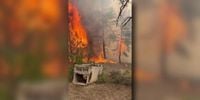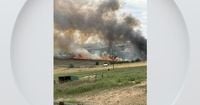Colorado is facing one of its most severe wildfire seasons in recent memory, with multiple blazes scorching vast swathes of land, prompting evacuations, and straining emergency resources across the state. As of August 8, 2025, wildfires had already consumed more than 100,000 acres—marking Colorado’s worst fire year since the historic blazes of 2020, according to data from the National Interagency Fire Center. With persistent drought, record-breaking heat, and a series of lightning strikes, the summer of 2025 has brought a perfect storm of conditions fueling these destructive infernos.
According to the U.S. Drought Monitor, much of Colorado’s Western Slope is currently classified under “severe” or “extreme” drought. These parched conditions, worsened by a dry winter and minimal snowpack, have left forests and grasslands primed for ignition. The Rocky Mountain Area Coordination Center, a Denver-based branch of the National Interagency Fire Center, issued a critical fire weather advisory for western Colorado and surrounding states, warning, “Extreme fire behavior marked by rapid spread, torching, and resistance to control is being driven by critically dry … fuels, and drought-stressed brush and trees. As heat intensifies and fuel moistures decline further, fire potential will remain elevated across the area.” This advisory is expected to remain in effect through at least mid-August.
The most significant of this year’s blazes is the Lee Fire, which erupted west of the town of Meeker in Rio Blanco County on August 2. Believed to have been sparked by lightning, the Lee Fire has rapidly expanded, burning an estimated 106,672 acres by August 10, with containment at just 6%. Its explosive growth has made it the seventh largest wildfire in Colorado’s recorded history, as reported by Colorado Newsline. The fire has not only threatened rural communities but has also forced authorities to prioritize structure protection with limited resources.
Just southeast of Meeker, the Elk Fire—also thought to have been ignited by lightning on August 2—has scorched approximately 14,635 acres, with containment efforts reaching 9% by August 8. Meanwhile, the Turner Gulch Fire, which began east of Gateway near the Colorado-Utah border on July 10, has burned through 28,403 acres and is nearly half contained at 49%. The Turner Gulch blaze, like the others, was set off by a lightning strike and has been fanned by high winds in recent weeks.
The impact of these wildfires has been profound, not only on the landscape but also on communities and infrastructure. On August 9, the Lee Fire prompted the evacuation of all 179 inmates at the Rifle Correctional Center. According to the Colorado Department of Corrections, the incarcerated individuals were relocated safely to the state prison in Buena Vista, and no injuries were reported. Staff remained on site to safeguard the facility and property, working closely with emergency management teams.
Governor Jared Polis has taken decisive action in response to these escalating threats. In early August, he issued disaster declarations for Delta, Mesa, Montrose, and Rio Blanco counties. On August 6, he mobilized the Colorado National Guard to bolster firefighting efforts on the Lee and Elk fires, recognizing the extraordinary strain on local and county resources. The governor’s office emphasized the need for state-level support, especially as the fires exceeded what local crews could manage alone.
But the challenges have not been confined to rural or mountainous areas. On August 10, a structure fire in the City of Craig, located on East 13th Street, quickly spread and became a wildfire. The Moffat County Sheriff’s Office issued evacuation notices for several blocks, though these were downgraded to pre-evacuation status by late afternoon. Nevertheless, officials continued to urge residents to stay away from the affected area near Yampa Avenue and 13th Street, emphasizing the ongoing danger and the need to follow emergency personnel instructions. Multiple agencies responded to the incident, and notably, no resources were diverted from the major Elk or Lee Fire containment efforts. One firefighter was transported for medical attention, although the specific reason was not disclosed.
The fire in Craig also led to significant disruptions in daily life. The Yampa Valley Electric Association announced an extended power outage after several utility poles were damaged by the flames. A public safety power shutoff was initiated, affecting not only Craig but also customers as far away as Baggs, Wyoming. The association promised to restore power as soon as conditions allowed.
Elsewhere in the state, the Oak Fire erupted west of Pagosa Springs in Archuleta County on August 10. What began as a structure fire rapidly escalated out of control, burning 75 acres north of Highway 160 in the Elk Park/Ironwood subdivision by the following morning. Governor Polis responded with a verbal disaster emergency declaration, once again enabling local agencies to draw on the Colorado National Guard and other state resources. As of August 11, mandatory evacuation orders remained in place, with a pre-evacuation warning for surrounding areas. The cause of the original fire has not been released, and, as of Monday morning, no additional structures had been reported lost. The Archuleta County Sheriff’s Office established an emergency call center for residents seeking information about the Oak Fire.
These fires are not isolated events but part of a troubling pattern driven by climate change. According to federal data, Colorado has grown hotter and drier over recent decades. The Western Slope, in particular, has warmed by more than four degrees Fahrenheit above pre-industrial levels. The current “megadrought” gripping the region is the worst in at least 1,200 years, a sobering statistic that underscores the scale of the crisis. The three largest wildfires in Colorado’s history all occurred in 2020, and the twenty biggest have been recorded within the past two decades.
While lightning has been the primary cause of this summer’s major wildfires, authorities caution that most fires are actually sparked by human activity. Officials urge visitors to national forests and public lands to observe fire restrictions, maintain their vehicles, secure trailer chains, and avoid driving or parking on dry grass. These precautions are vital, especially as more than 2.9 million Coloradans live in areas known as the “wildland-urban interface”—zones at heightened risk for wildfire impact. Fire safety experts recommend that residents familiarize themselves with the “Ready, Set, Go” system of emergency preparedness.
With the fire season far from over and critical fire weather advisories still in effect, Colorado’s communities remain on high alert. The state’s response—marked by swift evacuations, coordinated emergency management, and the mobilization of National Guard resources—reflects both the urgency of the moment and the growing recognition that wildfires, once rare, are now a recurring threat in a hotter, drier West.
As the flames continue to burn and communities rally together, Colorado’s resilience and adaptability are being tested like never before.

